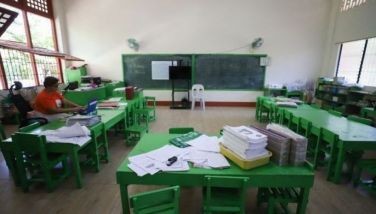Scars remain as CNN’s Stevens revisits Tacloban
MANILA, Philippines - Blue skies and the infamous Philippine summer heat greeted veteran journalist Andrew Stevens as he stepped off the plane at the Tacloban airport.
With the sun high in the sky, it was hard to believe that only six months before, the most powerful typhoon in the world had devastated the Visayan city. It was a dark spectacle that Stevens, who anchors CNN’s weekday morning show, had witnessed firsthand.
“It was just relentless. It was living with such damage and destruction 24/7, and seeing people who had lost so much, mothers who had lost their entire family. And it was wet. It was just hard with everything, just surviving in those conditions, surrounded by so much misery. It was depressing,†Stevens said, recounting his coverage of Typhoon Yolanda.
But time and storm have passed and Tacloban, though still struggling, has started to get back on its feet. The detritus that had once littered the streets of the city had been cleared. Food, though not as abundant as before, was once again readily available. Water and electrical services had been restored. Business, while not booming, was back to normal.
The scene that met Stevens was vastly improved from the one he had left behind in November last year. Still, recovery was not coming swiftly enough to the Leyte capital or to any of the other cities shattered by Typhoon Yolanda.
According to the latest report by the National Disaster Risk Reduction and Management Council (NDRRMC), over four million people across the Visayas were displaced by Typhoon Yolanda. The storm also damaged 1.14 million houses, nearly half of which were completely destroyed.
“The scars are still there. There’s a lot of tents. There’s still a lot of smashed houses,†Stevens said, adding, “Yes, there’s rebuilding. Yes, there’s a lot of people who’ve got roofs over their heads, but a hundred thousand people are still living in tents.â€
Government housing
The national government is currently in the process of providing permanent housing for victims of the super typhoon. A total of 214,000 houses will be built for families displaced by Typhoon Yolanda.
Yet, six months after the tragedy, only 130 have been completed, Stevens learned in a conversation with Secretary Panfilo Lacson, presidential assistant for rehabilitation and recovery.
The primary problem with the rebuilding project is the lack of usable land. According to Stevens, the government still needs to find a thousand hectares of land on which the houses can be built.
“The government says we want to build back, but we want to build back better,†the CNN anchor said, explaining that among the considerations for building new permanent housing now is the location and quality control over the integrity of the structures.
The houses should be able to withstand storms and earthquakes, and should be located in areas not prone to landslides and flooding from inland sources.
Stevens said, “The permanent stuff, it’s taking a long time, and it will take a long time.â€
Families with seven or more children have already been moved to temporary housing. Other displaced families have been left with no option but to return to the coast and rebuild their old homes, violating a regulation that no structures should be built within 40 meters of the sea.
“Just hours after the storm hit, I made my way right down to the waterfront and it was just rubble, flattened. I found the same place, I went back to it. It was all new-built, tin-roofed shanties – no stronger, no less vulnerable and still right in the danger zone,†said Stevens.
Master plan
The master plan for the rehabilitation of provinces affected by Typhoon Yolanda was completed and submitted last week.
According to Stevens, rehab czar Lacson expects this development to speed up the pace of rebuilding efforts within the next month.
With a plan now in the hands of the national government, pledges from donor countries are expected to come in. Currently, United Nations data show that only 56 percent of the donations have been delivered, Stevens said.
Should all foreign pledges push through, there should be sufficient funding for the rehabilitation of Tacloban and other areas devastated by the storm.
The government aims to finish all 214,000 houses by the time President Aquino steps down in 2016.
“It depends how much money comes in. If the money is there, I can’t see why it can’t be done,†Stevens said.
- Latest
- Trending



























